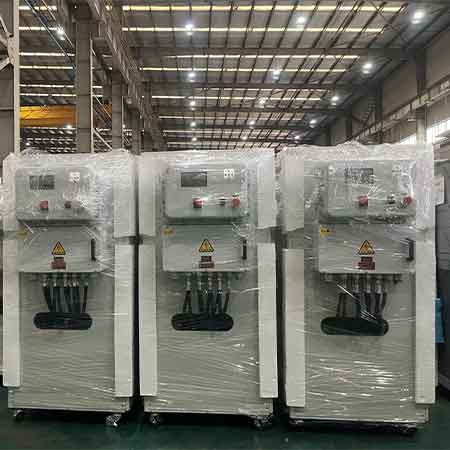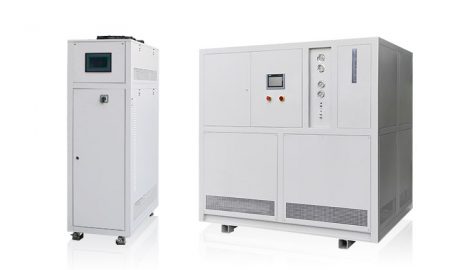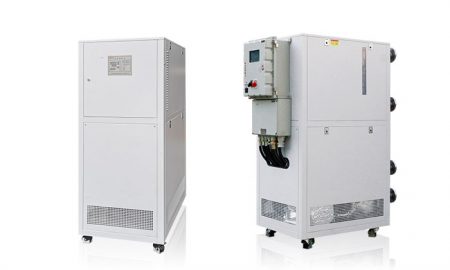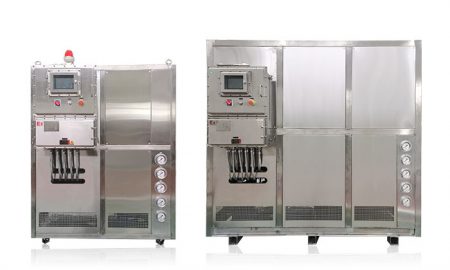Stand Alone Glycol Heating and Cooling Chiller
Contact us today for the perfect temperature control solution
With the development of science and technology and people’s increasing demand for environmental protection and energy saving, stand alone glycol heating and cooling chiller, as a new type of electromechanical equipment with high efficiency and energy saving, has gradually been widely used in industrial and commercial fields. It can provide cooling and heating functions at the same time, and achieve high-efficiency energy utilization through the cycle working principle.
Stand alone glycol heating and cooling chiller cycle process
1. Refrigeration cycle
The refrigeration cycle of a stand alone glycol heating and cooling chiller generally consists of an evaporator, a compressor, a condenser and a throttle valve. The ethylene glycol medium in the evaporator absorbs external heat, thereby cooling the air or liquid in the evaporator to achieve a cooling effect. Then, the ethylene glycol medium returned through the evaporator is compressed by the compressor, increasing its pressure and temperature. Then, the high-temperature and high-pressure ethylene glycol medium enters the condenser. Under the cooling effect of external water or air, the ethylene glycol medium dissipates heat and becomes a high-pressure liquid through the condensation process. Through the action of the throttle valve, the high-pressure liquid glycol medium enters the evaporator and restarts the next round of refrigeration process.
2. Heating cycle
The stand alone glycol heating and cooling chiller uses the evaporator in the refrigeration cycle as a heat storage device to achieve rapid storage and release of heat energy by controlling the direction and flow volume of the glycol circulating medium. When heating is required, the evaporator obtains heat energy from the outside by changing the direction of the circulating medium and stores it in the circulating medium. When heat energy needs to be released, the flow direction of the circulating medium is changed to release the stored heat energy into the object that needs to be heated.

How stand alone glycol heating and cooling chiller works?
The working principle of the stand alone glycol heating and cooling chiller is based on ethylene glycol as a circulating medium, which achieves energy transfer and conversion through cyclic flow during the cooling and heating processes.
1. Working principle of refrigeration
In the refrigeration cycle, the stand alone glycol heating and cooling chiller absorbs external heat into the glycol medium through the evaporator, causing the air or liquid in the evaporator to reach a low temperature state. This is because ethylene glycol evaporates easily under low pressure and absorbs a large amount of heat during the evaporation process, causing the internal temperature of the evaporator to drop. The compressor compresses the ethylene glycol medium, causing its temperature and pressure to increase. The condenser dissipates the heat of the ethylene glycol medium through the cooling of external water or air, turning it into a high-pressure liquid. Through the action of the throttle valve, the high-pressure liquid glycol medium enters the evaporator and restarts the next round of refrigeration cycle.
2. Working principle of heating
In the heating cycle, the stand alone glycol heating and cooling chiller releases the heat stored in the evaporator to the object that needs to be heated by changing the direction and flow of the circulating medium. When heating is required, the evaporator obtains heat energy from the outside by controlling the direction of the circulating medium and stores it in the ethylene glycol circulating medium. When heat energy needs to be released, the flow direction of the circulating medium is changed, and the heat energy is released from the glycol medium to the object that needs to be heated, achieving a fast and efficient heating effect.
The stand alone glycol heating and cooling chiller can not only meet the needs of modern society for cooling and heating, but also has the characteristics of energy saving and environmental protection, making it widely used in industrial and commercial fields.
Email: info@lneya.com WeChat ID: +8615251628237 WhatsApp: +86 17851209193

Cooling and Heating Systems (SUNDI series)
Temperature Control Range: -120°C to +350°C
Application: Various Reactors (Microchannels, Glass, Jacketed Reactors, etc.), Distillation or Extraction System, Laboratory, University, Research Institute, Aerospace, Automotive Industry, Semiconductor and Electrical Test, Chemical, Pharmaceutical, Petrochemical, Biochemical, Medical, Hospital, R&D Workshop, Aerospace, Biological and Other Industries.
| Temperature range | -10 ~ +150°C series | -25 ~ +200°C series | -25 ~ +300°C series | -45 ~ +250°C series | -45 ~ +300°C series | -60 ~ +250°C series | -60 ~ +300°C series | -70 ~ +250°C series | -80 ~ +250°C series | -90 ~ +250°C series | -100 ~ +100°C series | -25 ~ +200°C one machine for two reactors | -40 ~ +200°C one machine for two reactors |
| Cooling Capacity | 1.5 ~ 15kW | 1 ~ 200kW | 1 ~ 200kW | 0.45 ~ 200kW | 0.9 ~ 25kW | 0.25 ~ 60kW | 0.75 ~ 25kW | 0.4 ~ 15kW | 0.3 ~ 80kW | 0.2 ~ 80kW | 0.45 ~ 80kW | up to 10*2kW | up to 10*2kW |

Cooling and Heating Systems (WTD series)
(Micro channel / tube reactors specialized)
Temperature Control Range: -70°C to +300°C
Specialized design for micro channel (small liquid holding capacity, strong heat exchange capacity, circulation system high pressure drop)
| Temperature range | -70°C ~ +300°C | -45°C ~ +250°C | -70°C ~ +200°C |
| Cooling Capacity | 1.1 ~ 7.5kW | 1.5 ~ 5.5kW | 11 ~ 50kW |

Cooling and Heating Circulators
Temperature Control Range: -45°C to +250°C
Application: Various Reactors (Microchannels, Glass, Jacketed Reactors, etc.), Distillation or Extraction System, Laboratory, University, Research Institute, Aerospace, Chemical, Pharmaceutical, Petrochemical, Biochemical, Medical, Hospital, R&D Workshop, Aerospace, Biological and Other Industries.
| Temperature range | -25°C ~ +200°C series | -45°C ~ +250°C series |
| Cooling Capacity | 1 ~ 15kW | 0.25 ~ 15kW |

Heating Circulators
Temperature Control Range: +50°C to +300°C
Note: UC series can control the temperature of heat transfer medium. UST series can not only control the temperature of the heat transfer medium, but also control the temperature of the reaction material.
| Temperature range | +50°C ~ +170°C (UC series) | +50°C ~ +300°C (UC series) | +50°C ~ +300°C (UST series) |
| Heating Capacity | 5.5 ~ 15kW | 3.5 ~ 130kW | 3.5 ~ 95kW |

TCU Multi-reactors Temperature Control System
Temperature Control Range: -120°C to +250°C
Application: Various Reactors (Microchannels, Glass, Jacketed Reactors, etc.), Distillation or Extraction System, Laboratory, University, Research Institute, Aerospace, Chemical, Pharmaceutical, Petrochemical, Biochemical, Medical, Hospital, R&D Workshop, Aerospace, Biological and Other Industries.
| Temperature range | -45°C ~ +250°C series | -120°C ~ +250°C series | Customized Temperature Control System | RT+10°C ~ +135°C |
| Heating Capacity | 25 ~ 80kW | 25 ~ 80kW | Custom | 25 ~ 300kW |
 LNEYA
LNEYA
 简体中文
简体中文


















































































